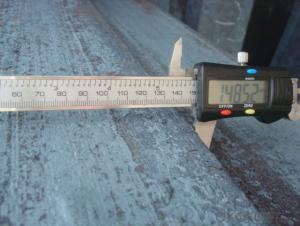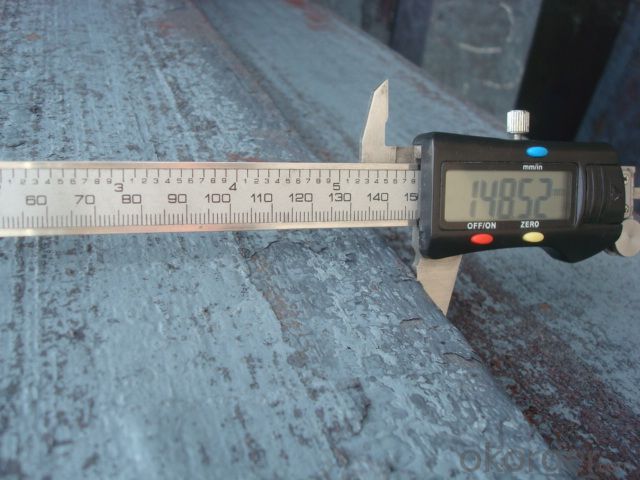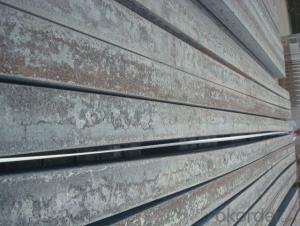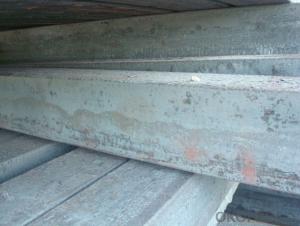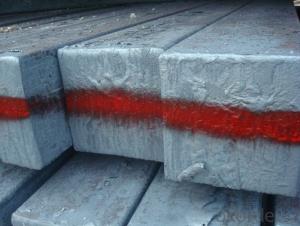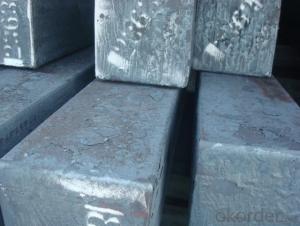Alloyed Continue Casting Steel Billet by Blast Furnace According to the Standard of YB2011-83
- Loading Port:
- Tianjin
- Payment Terms:
- TT OR LC
- Min Order Qty:
- 1000 m.t.
- Supply Capability:
- 100000 m.t./month
OKorder Service Pledge
OKorder Financial Service
You Might Also Like
Alloyed Continue Casting Steel Billet by Blast Furnace According to the Standard of YB2011-83
1.Structure of Alloyed Continue Casting Steel Billet by Blast Furnace According to the Standard of YB2011-83
Alloyed Continue Casting Steel Billet by Blast Furnace According to the Standard of YB2011-83 is the raw material of all kinds of steel mill. Billet section of square, round, flat, rectangular and abnormity, etc Several, mainly related to shape of rolled products. Simple rolled section steel, choose cross section of square billet or rectangular billet. rolling The sector products such as flat steel, Angle steel, select the rectangular billet or slab. Had better profiled billet when production beams, channels, and in rolling process Lines and improve the yield. The raw material of round billet is the production of seamless tube.
2.Main Features of Alloyed Continue Casting Steel Billet by Blast Furnace According to the Standard of YB2011-83
Steel Bloom Manufactured by Blast Furnace section size should meet the requirements of rolling deformation and finished product quality, but also roll strength and biting condition of restrictions. General steel Billet section height H. And the roll diameter D The ratio of the ( namely H/D) Should be less than or equal to zero 0.5 . Length of steel billet by finishing temperature, Rolling time and the length of the product Or times ruler. When heated too long accident prone to bump the furnace wall of steel, too short, furnace bottom utilization rate is not high, influence the heating furnace production. For the production Choose a variety of steel and steel billet, should consider the affinities of billet, as far as possible in order to improve the productivity of the roughing mill, simplify the stock management of workshop.
3. Alloyed Continue Casting Steel Billet by Blast Furnace According to the Standard of YB2011-83 Images
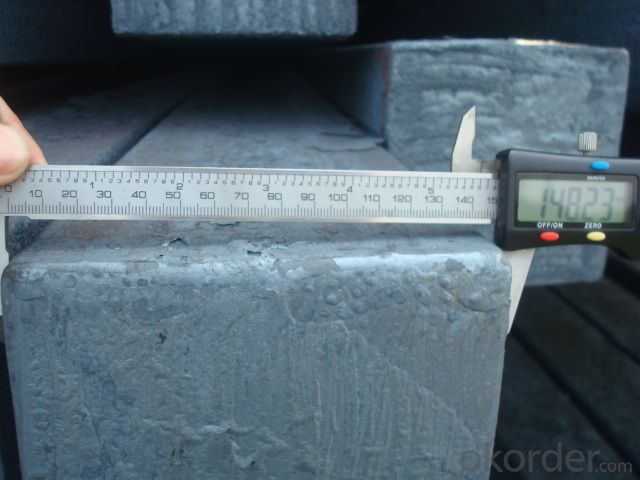
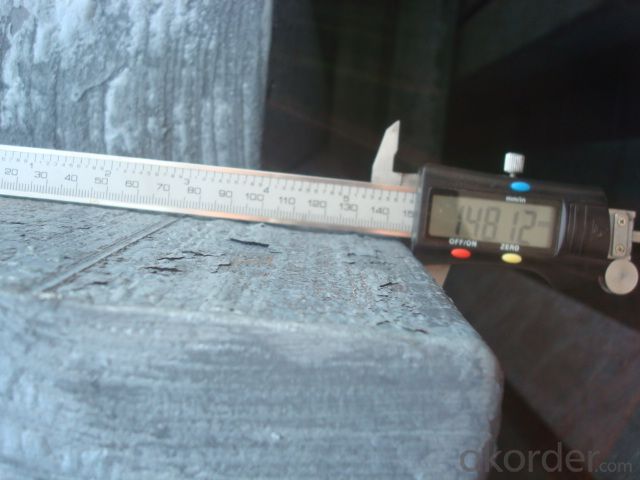
4. Alloyed Continue Casting Steel Billet by Blast Furnace According to the Standard of YB2011-83 Specification
Steel Bloom Manufactured by Blast Furnace rolled steel, after processing can be used for mechanical parts, forging parts, processing all kinds of steel, steel Q345B channel steel, wire rod is the role of the billet. Steel billet is used in the production of semi-finished products, generally cannot be used directly for the society. Steel billets and steel are strictly divided into standard, cannot decide to whether the business enterprise of the final product, and according to unified standards to perform the whole society. Typically, billet and the steel is relatively easy to distinguish, but for some steel billet, and have the same specification and same steel purposes (such as rolling tube billet), whether can be used for other industries, whether through steel processing process, whether through a finished product rolling mill processing to distinguish
Material standard The editor Range of thickness: 150-240 - mm + / - 5 mm width range: 880-1530 - mm + / - 20 mm Length: 3700-10000 - mm + / - 500 - mm Cross-sectional size: 64 * 64; 82 * 82; 98 * 98; 124 * 124; 120 * 150; 152 * 164; 152 * 170 mm Length: 9000 mm Section of tolerance: billet: 1.0 + / - 2.0-1.0 + / - 1.0 mm slab: width: + / - 2.0 mm thickness: + / - 3.0 mm The length tolerance: + / - 200 mm Section diagonal tolerance: 3.5-8.0 MM Billet section size protrusions requirements: < 1242 mm, do not allow; > = 1242 mm, < = 2 mm 1242 mm, < = 3 mm Beheading (shear) extension deformation: < 1242 mm billet: no control; The slab: < = 15 mm Surface tilt: no more than billet section 0.1 Bending: every 1 m length is not more than 10 mm The distortion: length < = 5 m, < = 11. ; The length of the < = 7.5 M, < = 5. Material % 3 sp/PS chemical composition: C Mn Si S P
5.FAQ of Alloyed Continue Casting Steel Billet by Blast Furnace According to the Standard of YB2011-83
We have organized several common questions for our clients,may help you sincerely:
①How about your company?
A world class manufacturer & supplier of castings forging in carbon steel and alloy steel,is one of the large-scale professional investment casting production bases in China,consisting of both casting foundry forging and machining factory. Annually more than 8000 tons Precision casting and forging parts are exported to markets in Europe,America and Japan. OEM casting and forging service available according to customer’s requirements.
②How to guarantee the quality of the products?
Crack in continuous casting billet surface shall not be visible to the naked eye, overlapping, skull patch, or scarring, inclusion and depth
Height is greater than the
3 mm
Scratches, indentation, scratch, pores, wrinkles, cold splash, handle, bump, pits
And depth is greater than the
2 mm
The hairline.Casting billet cross-section can not have shrinkage cavity, subcutaneous bubble.
Crack in continuous casting billet surface shall not be visible to the naked eye, overlapping, skull patch, or scarring, inclusion and depth
Height is greater than the
3 mm
Scratches, indentation, scratch, pores, wrinkles, cold splash, handle, bump, pits
And depth is greater than the
2 mm
The hairline.Casting billet cross-section can not have shrinkage cavity, subcutaneous bubble.
③How to check the appearance?
Appearance standard 2.1And the difference between the lengths of the continuous casting billet in cross section of diagonal should conform to the table2The provisions of the. 2.2And the degree of curvature of continuous casting billet per meter shall not be greater than20 mm,The total bending shall not be greater than the total length2%. 2.3, casting billet are allowed drum belly, but height shall not exceed the casting billet length allowed is deviation. 2.4Oblique cutting, casting billet end shall not be greater than20 mm. 2.5Casting billet end caused by shear deformation, spread shall not be greater than the length10%. 2.6, casting billet can not have apparent reverse..
- Q: How are steel billets stored to prevent rusting?
- To prevent rusting, various measures are taken to store steel billets. Firstly, a dry and controlled environment with low humidity levels is typically utilized. This helps to minimize the presence of moisture, which is a primary catalyst for rust formation. Additionally, a protective layer such as oil or a rust inhibitor is often applied to the steel billets. This creates a barrier between the metal surface and the surrounding atmosphere, acting as a shield against moisture and oxygen. By preventing contact between these elements and the steel, rust formation is effectively hindered. Furthermore, to further reduce the risk of moisture absorption, steel billets are often stored off the ground. This is achieved by using pallets or racks to elevate the billets, allowing for proper air circulation. By doing so, the chances of condensation and subsequent rusting are greatly reduced. Regular inspection and maintenance are also vital in preventing rusting. Any signs of corrosion or damage to the protective coating should be promptly addressed to ensure the integrity of the steel billets. By implementing these storage practices, steel billets can be effectively safeguarded against rusting, ensuring their quality and usability for extended periods of time.
- Q: What are the common defects in steel billets during hot rolling?
- Some common defects in steel billets during hot rolling include surface cracks, internal cracks, surface scales, segregation, and surface defects such as pits, scars, and scratches. These defects can affect the quality and integrity of the final product and may require further processing or rejection of the billets.
- Q: What are the main safety considerations when handling steel billets?
- The main safety considerations when handling steel billets include wearing appropriate personal protective equipment such as gloves, safety glasses, and steel-toed boots to protect against potential injuries. Proper lifting techniques should be used to prevent strains and back injuries when moving heavy billets. Additionally, ensuring a well-organized and clutter-free work area, as well as proper storage and stacking of the billets, can help prevent accidents and injuries.
- Q: What are the main types of defects found in steel billets?
- Steel billets can suffer from a range of defects, including surface defects, internal defects, and segregations. Surface defects refer to any abnormalities, cracks, or discontinuities that can be found on the outer surface of the steel billet. These defects encompass scale, scratches, pits, and surface cracks. They are typically caused by mishandling during transportation or storage, improper handling during manufacturing, or insufficient surface cleaning. Internal defects are flaws or imperfections that exist within the inner structure of the steel billet. These defects include inclusions, cavities, blowholes, porosity, and non-metallic inclusions. They can be a result of improper melting and casting processes, incorrect cooling and solidification, or the presence of impurities in the steel. Segregations involve the uneven distribution of elements or impurities within the steel billet. As a consequence, certain sections of the billet may possess different chemical compositions or mechanical properties. Inadequate mixing during the melting process, improper pouring and solidification, or the presence of impurities in the raw materials can cause segregations. To ensure the quality and integrity of steel billets, it is essential to detect and rectify these defects. Various non-destructive testing techniques, such as visual inspection, ultrasonic testing, magnetic particle testing, and eddy current testing, are employed to identify and characterize these defects. Once identified, appropriate measures, including grinding, machining, or heat treatment, can be implemented to eliminate or mitigate the defects.
- Q: How are steel billets used in the production of automotive braking systems?
- Steel billets are an important component in the production of automotive braking systems. These billets are essentially semi-finished steel products that are used as raw material for further processing. They are typically manufactured through the process of casting, where molten steel is poured into molds and allowed to solidify. In the context of automotive braking systems, steel billets are primarily used to manufacture brake rotors or discs. These components play a crucial role in the braking system as they provide the surface on which the brake pads make contact and create friction, ultimately stopping the vehicle. Brake rotors are subjected to high levels of stress and heat during braking, and therefore require a material that is strong, durable, and heat-resistant, which is where steel comes into play. Once the steel billets are obtained, they undergo a series of manufacturing processes to transform them into brake rotors. The first step involves heating the billets to a specific temperature, which helps to enhance their malleability and make them easier to shape. This is followed by a process called forging, where the heated billets are subjected to high pressure to shape them into the desired form of the brake rotor. This forging process helps to improve the strength and integrity of the steel, making it more resistant to wear and deformation. After forging, the brake rotor undergoes additional machining processes. This includes turning the surface of the rotor to ensure it is flat and smooth, thus providing an even contact surface for the brake pads. The rotor may also be drilled or slotted to improve heat dissipation and prevent the buildup of gases or debris between the pad and rotor. These machining processes help to achieve the required dimensions and surface finish of the brake rotor. Once the brake rotor has been manufactured, it is then assembled with other components of the braking system, such as brake calipers, pads, and hydraulic lines, to create a functional braking system. The steel billets used in the production of brake rotors ensure that the braking system is reliable, durable, and capable of withstanding the demanding conditions of automotive braking. In summary, steel billets are essential in the production of automotive braking systems as they are transformed into brake rotors, which are crucial components for stopping vehicles. The billets are heated, forged, and machined to achieve the desired dimensions, strength, and surface finish of the rotor. The end result is a reliable and durable braking system that ensures the safety and performance of the vehicle.
- Q: Are steel billets prone to corrosion?
- Steel billets are not inherently prone to corrosion. However, their susceptibility to corrosion depends on the specific type of steel used and the environmental conditions they are exposed to. Stainless steel billets, for example, contain a significant amount of chromium which forms a protective layer on the surface, making them highly resistant to corrosion. On the other hand, carbon steel billets, which do not have this protective layer, are more susceptible to corrosion. The presence of moisture, oxygen, and certain chemicals can accelerate the corrosion process. Therefore, it is important to properly store and handle steel billets, as well as apply appropriate coatings or treatments to minimize the risk of corrosion.
- Q: What are the different types of steel used for manufacturing billets?
- Manufacturing billets commonly employ various types of steel, each possessing unique properties and applications. Some frequently utilized steel types for this purpose encompass: 1. Mild Steel: Widely employed for billet manufacturing, mild steel exhibits low carbon content and is renowned for its strength and ductility. It suits general-purpose applications that do not necessitate high strength. 2. Carbon Steel: Containing higher carbon levels than mild steel, carbon steel offers enhanced hardness and strength. Hence, it is suitable for wear-resistant applications like tools and machinery components. 3. Alloy Steel: Alloy steel is produced by incorporating diverse alloying elements, including manganese, nickel, chromium, or molybdenum, into the base iron. Consequently, it exhibits augmented strength, durability, and corrosion resistance. The automotive, aerospace, and construction industries typically employ alloy steel billets. 4. Stainless Steel: Stainless steel is an alloy comprising at least 10.5% chromium, which endows it with remarkable resistance against corrosion and staining. Consequently, it is ideal for applications requiring high hygiene levels, such as food processing equipment and medical devices. 5. Tool Steel: Tool steel, a high-carbon steel, is specifically engineered for tool, die, and mold production. It is renowned for its hardness, wear resistance, and ability to retain shape at elevated temperatures. 6. High-Speed Steel: This type of tool steel is designed to endure high temperatures without compromising its hardness. It is frequently employed for cutting tools like drills and milling cutters. These examples merely represent a fraction of the steel types utilized for billet manufacturing. The selection of steel hinges upon specific requirements, such as strength, durability, corrosion resistance, and temperature resistance, dictated by the application at hand.
- Q: How do steel billets contribute to energy efficiency?
- Steel billets contribute to energy efficiency in several ways. Firstly, the production of steel billets typically involves recycling scrap metal, which requires significantly less energy compared to producing steel from raw materials. This recycling process helps conserve energy and reduces the carbon footprint associated with steel production. Additionally, steel billets are often used as a raw material in various industries, such as construction and manufacturing. The durability and strength of steel make it a long-lasting and energy-efficient material for building structures and producing goods. Its high thermal conductivity also allows for efficient heat transfer, making it suitable for applications that require temperature control or energy conservation. Overall, steel billets play a vital role in promoting energy efficiency by minimizing energy consumption during production and offering sustainable solutions in various sectors.
- Q: What is the role of steel billets in the manufacturing of automotive suspension systems?
- The role played by steel billets in the manufacturing of automotive suspension systems is crucial. These systems are responsible for ensuring a comfortable and smooth ride while maintaining the stability and handling of the vehicle. Various components of the suspension system, including control arms, coil springs, sway bars, and stabilizer links, are fabricated using steel billets as the raw material. Strength and durability are primary requirements for suspension systems, and steel billets are an ideal choice for manufacturing suspension components due to their high tensile strength and excellent mechanical properties. Carbon steel is commonly used to make these billets because of its exceptional strength and ability to withstand the heavy loads and forces encountered by suspension systems. The process of manufacturing suspension components from steel billets involves several stages. Initially, the billets are heated to a specific temperature, typically above their recrystallization temperature, to make them more malleable. This enables the material to be easily shaped and formed into the desired component. After heating, the billets undergo various forming processes such as hot forging, cold forging, or machining, depending on the specific component being manufactured. These processes help shape the billets into control arms, coil springs, or other suspension components with precise dimensions and specifications. The use of steel billets in suspension systems offers several advantages. Firstly, steel is a cost-effective material, making the overall manufacturing process more economical. Moreover, steel provides an excellent strength-to-weight ratio, allowing for lighter suspension components without compromising on strength and durability. This, in turn, contributes to improved fuel efficiency and overall vehicle performance. Additionally, steel billets have high resistance to wear, corrosion, and fatigue, ensuring that the suspension components can endure harsh operating conditions and have a long lifespan. They also possess excellent damping characteristics, which help absorb and dissipate vibrations and shocks, further enhancing the comfort and stability of the vehicle. In conclusion, steel billets play a crucial role in the manufacturing of automotive suspension systems. Their strength, durability, and malleability make them an ideal raw material for fabricating various suspension components. By utilizing steel billets, automotive manufacturers can produce suspension systems that provide a smooth ride, stability, and enhanced performance, contributing to the overall comfort and safety of drivers and passengers.
- Q: What are the common surface defects in steel billets during reheating?
- Common surface defects in steel billets during reheating include scale formation, decarburization, and oxidation. Scale formation occurs due to the reaction between the steel surface and the surrounding atmosphere, resulting in the formation of a layer of iron oxide. Decarburization is the loss of carbon content from the steel surface, leading to reduced strength and hardness. Oxidation refers to the reaction between oxygen and the steel surface, causing the formation of iron oxide and potentially weakening the material. These defects can affect the quality and performance of the steel billet if not properly addressed.
Send your message to us
Alloyed Continue Casting Steel Billet by Blast Furnace According to the Standard of YB2011-83
- Loading Port:
- Tianjin
- Payment Terms:
- TT OR LC
- Min Order Qty:
- 1000 m.t.
- Supply Capability:
- 100000 m.t./month
OKorder Service Pledge
OKorder Financial Service
Similar products
Hot products
Hot Searches
Related keywords
